Understanding Green Baler Parts in Agriculture Today
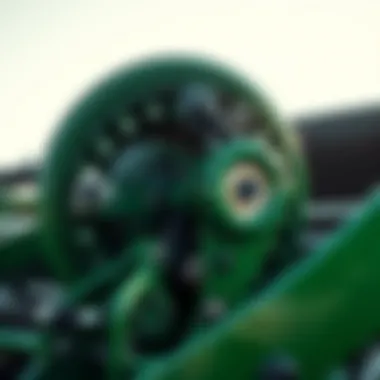
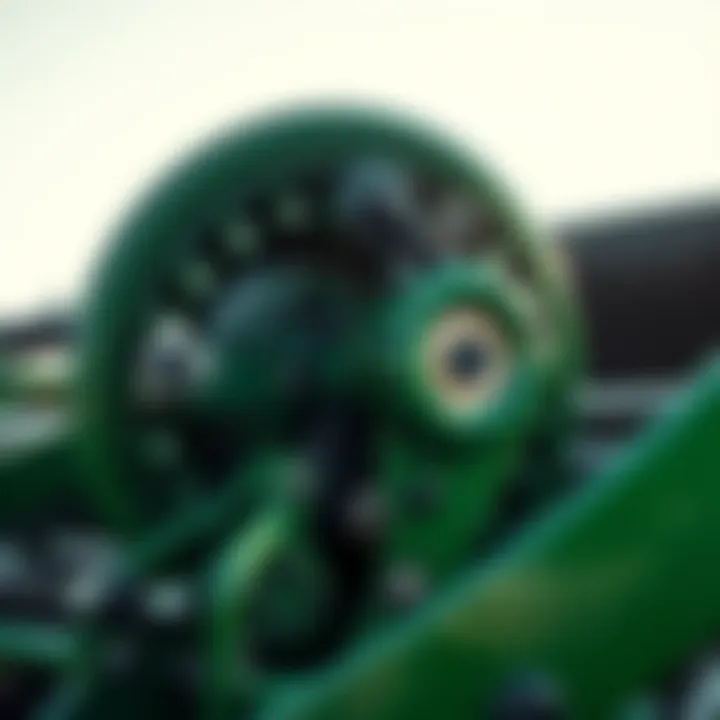
Intro
The realm of modern agriculture is vast, interspersed with machines and technology that continually reshape how farming is conducted. One such essential piece of equipment that plays a critical role in this transition is the baler. Specifically, green balers, designed for harvesting grass and forage crops, stand as a cornerstone in managing crop outputs efficiently. Understanding the intricate parts that make up these machines opens a window into not only their functionality but their advancement and maintenance crucial for optimizing agricultural performance.
Diving into the specifics of green baler parts—what they are, how they function, and their impacts on farming practices—reveals an essential narrative of contemporary agricultural practices.
Topic Overview
Definition and Importance
Green balers are specialized machinery used to compress typically loose crops into compact bales. These bales can range in size and shape, often identified as round or square. The importance of green balers in modern agriculture cannot be overstated: they help in efficient storage, easy transportation, and effective feed management for livestock. When we consider the mounting pressures of agricultural efficiency combined with sustainability, understanding baler parts becomes paramount.
Brief History and Evolution
Traditionally, hay and forage were handled manually or with primitive tools. The introduction of balers in the early 20th century revolutionized crop management. The designs have evolved significantly, transitioning from wooden components in early models to the current sophisticated metal and electronic interfaces. Nowadays, computerized systems allow for precision in both operation and maintenance, adding a layer of efficiency that was once unimaginable.
Experts suggest that the evolution of green baler technology correlates directly to agricultural productivity, as farmers strive for methods that not only keep pace with demand but also promote sustainability. Understanding this evolution aids in grasping current innovations and their implications for the future of farming.
Key Techniques and Innovations
Sustainable Farming Practices
With the growing emphasis on sustainable farming, the use of green balers has introduced several ecological practices. For instance, newer models often incorporate features that reduce waste, making them not just effective but eco-friendly.
- Variable Density Baling: This technique allows for adjustments in the density of the bales, ensuring that farmers can optimize storage and material preservation.
- Integrated Monitoring Systems: Such systems track the moisture content of the forage, ensuring that only the best quality is preserved, thus minimizing spoilage and waste.
Each of these innovations speaks to a larger conversation about sustainable agriculture and efficient resource management, vital for the survival of farming practices in an increasingly demanding world.
Advanced Agronomic Technologies
Close ties exist between green balers and advanced technologies, such as GPS and machine learning. These advancements enhance the functionality of balers, supporting smart farming initiatives. For example, GPS-guided baling ensures accuracy in field work, maximizing yield while minimizing overlap and wasted resources.
- Data Analysis Tools: Farmers today can gather data on soil conditions, crop health, and even weather patterns, utilizing that information to enhance their baling practices.
- Automation: Many balers now boast semi-automated systems that streamline operation, lessening the burden on operators and enhancing productivity.
Practical Applications
Step-by-Step Guides
Maintaining a green baler ensures optimal performance and its longevity. Regular checks are an essential part of equipment management. Focusing on the main components—like the knife system, belts, and chamber settings—can help avoid issues that could slow down operations.
- Inspect the Knife System: Ensure blades are sharp and in good condition, which increases cutting efficiency and reduces strain on the machine.
- Check Belts for Wear: Belts should be replaced if frayed or excessively stretched; functionality relies heavily on these parts moving smoothly.
- Monitor Hydraulic Functions: Keep an eye on hydraulic pressure, as this is essential for determining how effectively the baler operates.
Case Studies or Real-World Examples
To illustrate the practical implications of maintaining green balers, consider a farm in the Midwest that employs advanced baling technology. After investing in a new model with integrated monitoring systems, the farm saw a 20% decrease in waste due to improved moisture control. Such advancements not only enhance productivity but also align with sustainable farming practices.
"Investing in the right parts and technologies can transform everyday farming into a highly efficient operation. A green baler isn’t just a machine; it’s an investment in future productivity and sustainability."
By closely examining these case studies, we can understand that the deployment and maintenance of green balers encapsulate a blend of traditional practices and cutting-edge innovations, paving pathways for smarter agricultural practices that benefit both producers and the environment.
For further reading on agricultural innovations, visit resources like wikipedia.com or britannica.com to explore in-depth articles regarding agricultural machinery.
Prologue to Green Balers
In the evolving landscape of agriculture, green balers emerge as pivotal components in crop management, ensuring that the process of collecting and compressing forage has become more refined and efficient. This introduction not only sets the stage for understanding the essentials of balers but also underlines their significance in modern farming practices. With the pressing need for sustainable agriculture, the role of green balers extends beyond mere functionality; they are key actors in optimizing resources, thereby influencing both yield quality and soil health.
The primary crux of this section delves into what green balers are and the mechanics that underlie their operation. For farmers of every stripe—whether seasoned or just entering these fields—the comprehension of baler functionalities can lead to improved practices, ultimately benefiting their output and the health of the lands they cultivate. With this in mind, the focus shifts to two specific elements: their definition and functionality, alongside the historical context of these machines, to provide a rounded understanding of how we got to where we are today.
Definition and Functionality
Green balers are machines designed to collect and package agricultural materials—principally grasses, straw, and hay—into compact bales for easy transport and storage. At a glance, their definition may seem simple, but the functionality and operations involved are quite intricate. These machines can vary widely in design, size, and features. Yet, their purpose remains the same: to create bales that preserve the quality of the harvested material, making it easier for farmers to handle and utilize the crop effectively.
The functionality of a green baler hinges on several key components, including the feed system that gathers material and the compression mechanisms that shape it into bales. In modern versions, features often include automatic tie systems that secure the bales, reducing the need for manual involvement.
Such advances not only enhance efficiency but also contribute to consistent output which is crucial during peak harvest times.
Historical Context
To appreciate the significance of green balers today, understanding their evolution helps paint a broader picture. The journey began with manual methods of gathering and stacking hay, which were labor-intensive and often inefficient. The innovation of the first mechanical balers in the late 19th century marked a turning point—these machines revolutionized how farmers processed and transported their crops.
As technology progressed, balers incorporated more features intended to ease operations. The 20th century brought about significant advancements, including hydraulic and electronic systems, which further streamlined processes.
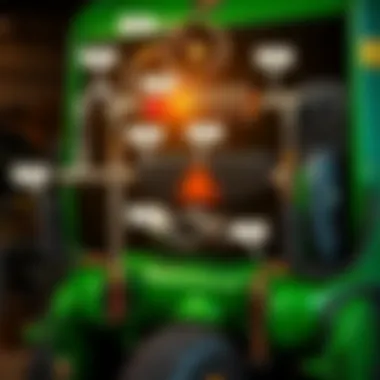
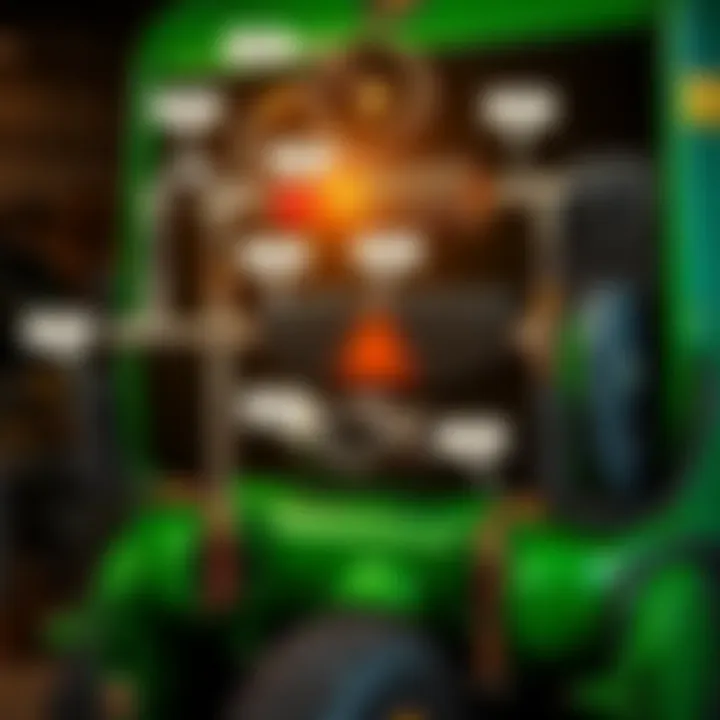
Looking at the broader picture, the transition from manual labor to mechanization indicates a crucial shift in agricultural practices, aiming to not only increase productivity but also tackle the growing demands of food supply as populations expanded.
In examining these perspectives—both definitions and historical contexts—farmers and agronomy enthusiasts gain valuable insights that can impact their daily operations. A well-rounded understanding of green balers enables informed decision-making, which is vital in today’s competitive agricultural environment.
Key Components of Green Balers
Understanding the key components of green balers is like peeking under the hood of modern agriculture's machinery. These parts are essential not only for efficient functioning but also for the increasing demands of sustainable farming practices. Each component plays a specific role, contributing to the overall purpose of the baler: to compact and bind crop material into easy, transportable bales. An intricate balance exists within the functioning of these components, and a failure in one can lead to operational setbacks.
Feed Systems
Let’s start with feed systems – the unsung heroes of balers. They serve as the entrance for raw crop material. Depending on the crop type, different feed mechanisms exist. Some balers might utilize augers, which act like screw conveyors, drawing material from a pile and feeding it into the compression chamber. Meanwhile, others could have belt systems that gently transport material without damaging delicate crops. A well-designed feed system can dramatically affect the efficiency of the baler, ensuring a steady flow of material and reducing jamming occurrences.
Another interesting aspect of feed systems is their adaptability. Many contemporary units come equipped with sensors that monitor the flow of material and adjust the feeding rate accordingly. This smart technology not only helps in maintaining consistency but also reduces waste. Operators should regularly check for blockages or wear and tear in the components to ensure that the feed systems work optimally, as neglecting these could mean losses in productivity.
Compression Chambers
Next up are compression chambers, the core of any baler. This is the zone where magic happens—where loose crop material transforms into tightly packed bales. Compression is powered through a series of hydraulic or mechanical systems, and the effectiveness of this chamber is paramount. If the compression isn't done correctly, the bales may be too loose or not uniform, making transport and storage cumbersome.
Operators must be mindful of adjusting the settings based on the type of material being processed. For instance, dry hay compresses differently than moist silage. The chamber design, including its shape and the presence of any moving parts, also influences the compressibility of the material. Operators need to ensure that the chamber remains clean and free of foreign objects that could impede its function. Clogged or damaged compression chambers can lead to extra wear on the machinery and higher operational costs.
Balers' Knotting Mechanisms
The last piece in the puzzle is the knotting mechanism, an often underestimated but pivotal component. After the compression stage, the baler ties off the bales, ensuring they hold together during handling. There are various designs here too, with some balers using twine and others opting for net wrap. Each option has its merits depending on the specific use case.
The knotting process involves a series of precise mechanical actions. A slip in this mechanism could spell disaster—either resulting in poorly tied bales or complete mechanical failure. Regular maintenance on these systems is non-negotiable. Operators should be vigilant, checking the various parts for wear, ensuring the twine or net is fed correctly, and that none of the knots are compromised. Any time-consuming interruptions caused by knotting failures can range from frustrating to costly.
"The efficiency of green balers hinges on understanding and maintaining its key components. Investing time in keeping these parts in check translates into smoother operations and better crop management."
In summary, the core components of feed systems, compression chambers, and knotting mechanisms work together to enhance the overall efficiency of green balers. By understanding their functions and importance, agricultural professionals can make informed decisions that promote a sustainable, productive farming environment.
Maintenance of Green Baler Parts
Proper maintenance of green baler parts is critical in ensuring optimal performance in agricultural operations. A well-maintained baler operates more efficiently, minimizes downtime, and extends the life of the machinery. Neglecting maintenance can lead to costly repairs and impacts productivity, which ultimately affects the bottom line. Keeping balers in prime condition is not just about prolonging machinery life; it's also about maximizing yield and reducing waste during the baling process.
Routine Inspections
Routine inspections are an essential part of green baler maintenance. Scheduling regular checks helps identify potential issues before they escalate into significant problems. Farmers often overlook minor wear and tear, which can snowball into major breakdowns. Inspecting components like belts, chains, and the knotting mechanism should be standard practice. These checks are beneficial because they reveal how different parts are wearing and functioning in real-world conditions.
Performing an inspection could include:
- Checking for loose bolts or screws that might vibrate loose during operation.
- Examining belts for signs of fraying or cracking.
- Testing the knotting system to ensure it functions correctly and doesn't leave loose bales.
By incorporating routine inspections into the operational schedule, farmers can save time and money by preventing unexpected repairs. The peace of mind that comes with knowing that equipment is in optimal condition is also invaluable.
Replacement of Worn Parts
Eventually, even the best-maintained balers will require parts replacements. Identifying when to replace worn parts is crucial and can significantly affect productivity. Worn out components not only lead to inefficiencies but can also create safety hazards on the farm. It's essential to have a good understanding of the machinery to recognize signs that certain parts need replacement.
When it comes to replacing parts, consider the following:
- Frequency of use: Parts subjected to more significant wear should be monitored more closely, considering how often the baler is in use.
- Type of materials handled: Heavier or more abrasive materials can wear components down faster than lighter crops.
- Manufacturer recommendations: Many manufacturers provide guidelines on when specific parts should be replaced, based on usage.
Replacing worn parts before they fail ensures that the baler remains functional and efficient, preventing loss of time during critical harvesting times.
Lubrication Practices
Lubrication practices are another cornerstone of maintaining green baler parts. Proper lubrication reduces friction, which can lead to increased wear and tear on components. Understanding which parts need regular lubrication, and how often to do it, is vital for keeping a baler running smoothly.
Here are a few tips on lubrication practices:
- Frequency: Lubricate based on usage; more significant use means more frequent lubrication.
- Type of lubricant: Use recommended lubricants specified by the manufacturer to avoid compatibility issues with components.
- Pay attention to high-friction areas: Focus on areas like bearings, chains, and shear bolts, as they incur the most wear.
Neglecting lubrication can create an environment ripe for friction and heat buildup, ultimately leading to premature component failure. It’s a straightforward practice that reaps considerable benefits in machinery longevity.
Regular maintenance, including routine inspections, timely replacement of worn parts, and diligent lubrication practices, leads to more sustainable agricultural operations. By investing in upkeep today, farmers can secure productivity for tomorrow.
Innovations in Baler Technology
Innovations in baler technology play a crucial role in transforming agricultural practices. With farming becoming increasingly tech-centric, the advent of new technologies not only streamlines the baling process but also enhances productivity and sustainability. Farmers today face the challenge of maximizing efficiency while minimizing environmental impact, and the innovations discussed in this article make strides towards these goals.
Automation in Baler Functions
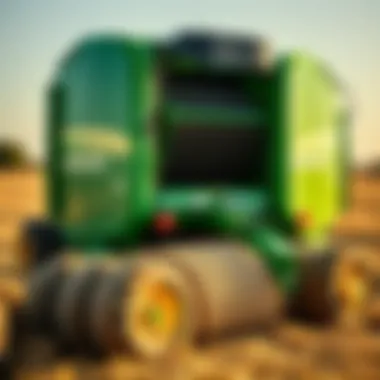
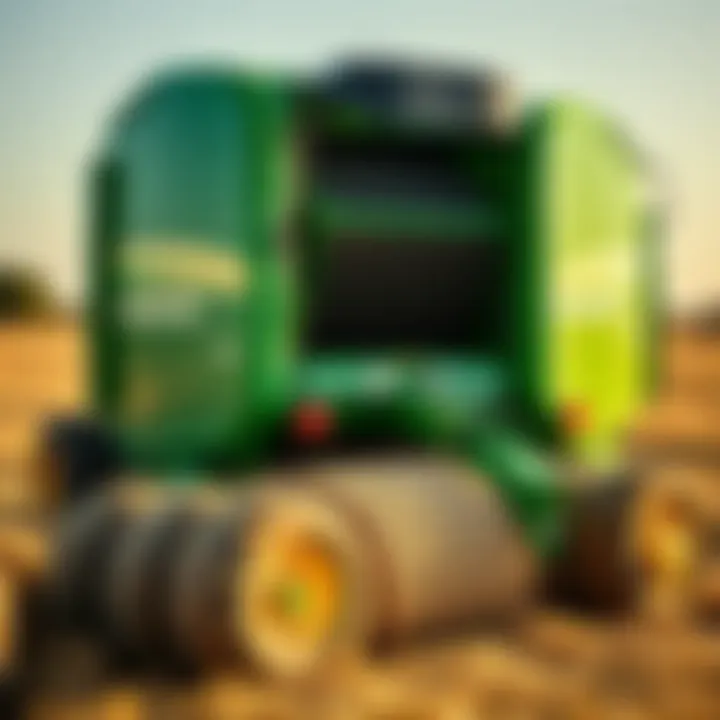
Automation in baler functions has revolutionized how farmers approach crop handling. By employing robotics and semi-automated systems, tasks that once took considerable time and labor can now be executed with precision and speed.
- Intelligent Positioning: Modern balers can automatically position themselves for optimal operation based on factors like crop density and moisture. This ensures high-quality bales that are less prone to damage.
- Data Tracking: Automation also provides farmers with data analytics tools, offering insights into machine performance and crop conditions. This information can be invaluable for making informed decisions on when to harvest or adjust equipment settings.
- Labor Efficiency: With automatic binding and wrapping features, manual labor is reduced. This allows farmers to allocate their workforce to more essential tasks, such as monitoring crop health or planning for future planting cycles.
In the landscape of modern agriculture, these automated functionalities are not just conveniences but necessities for competing in today’s market.
Smart Technology Integration
The integration of smart technologies into balers offers significant advancements that bolster efficiency and sustainability. From real-time monitoring systems to IoT capabilities, these features enhance the traditional baling processes.
- Real-time Monitoring: Farmers can now track the baler’s performance in real-time through mobile applications. These apps provide alerts about potential issues, reducing downtime and ensuring consistent operation.
- IoT Connectivity: By connecting balers to the Internet of Things, users can aggregate data from multiple machines, allowing for greater visibility over large-scale operations. This connectivity aids in predictive maintenance, ensuring equipment is serviced before breakdowns occur.
- Precision Agriculture: Smart balers can analyze the quality of the hay or straw being processed, allowing farmers to adjust their techniques based on crop conditions and maximizing both yield and quality.
The implementation of cutting-edge technology in balers signifies a shift towards a more modernized and efficient agricultural environment.
These innovations not only enhance the effectiveness of balers but also encourage a more sustainable farming approach. With rising consumer demand for sustainable practices, incorporating these technologies is a key step for today’s farmers.
Impact on Sustainable Practices
Understanding how green balers fit into the overarching framework of sustainable agriculture is essential for modern farming. The focus on sustainable practices has escalated in importance, as farmers look for ways to reduce their environmental footprint while maintaining productivity. Green balers play a pivotal role in this endeavor, not just in streamlining operations but also in fostering a more harmonious relationship with the land.
Reducing Waste in Crop Management
One of the pressing challenges in agriculture today is managing crop residues effectively. After harvest, various plant materials—like straw, leaves, and husks— are often left behind, leading not only to waste but also to potential pest issues and nutrient loss. Utilizing green balers helps in converting these residues into compact bales that can be easily transported and stored. This efficiency minimizes waste, effectively recycling organic material back into the soil or transforming it into livestock feed.
"By efficiently baling crop residues, farmers can reduce post-harvest losses and contribute to a more circular agricultural economy."
For instance, some farmers have reported that using balers has allowed them to repurpose straw leftover from wheat harvests, reducing the need for synthetic fertilizers by adding natural organic matter back into the soil. This practice not only improves soil structure but also enhances its ability to hold moisture, reducing the need for irrigation.
Additionally, employing this technology accelerates the decomposition process when bales are used as mulch. They can provide incredibly valuable organic inputs for the next planting season, thus cutting down on waste while boosting sustainability.
Enhancing Soil Health Through Proper Baling
Soil health stands at the core of sustainable agriculture, and the way green balers are employed can significantly influence this vital resource. Proper baling techniques can aid in enhancing soil health by managing organic materials more effectively. When crop residues are properly baled and returned to the field, the benefits multiply.
Baled materials can decompose on the soil surface, adding essential nutrients into the soil. This process helps in building a healthier microbiome that fosters plant growth. Furthermore, materials that decompose under favorable conditions (as created by covering soil with bales) improve soil aeration and structure, which are critical for root development.
The net effect of these practices is a robust ecosystem where nutrient cycles are preserved, ultimately preventing soil erosion and promoting long-term agricultural sustainability.
Collectively, the role of green balers in crop management and soil health cannot be overstated. These machines not only contribute to reducing waste but also enhance the functional attributes of the soil. As farmers continue to embrace sustainable practices, the significance of proper baling will only be amplified, signaling a dependent relationship between technology and stewardship of the land.
Understanding the Different Types of Balers
When it comes to balers, understanding the different types is crucial for making informed decisions in agricultural practice. Balers are not just ordinary machines; they play a pivotal role in the effective management of crop materials. Selecting the right baler can lead to enhanced efficiency and yield. Each baler type—square or round—comes with its distinct features and benefits that align with varying farming needs. Making a choice isn’t just about preference but about practical applications, efficiency in the field, and the economical aspect of the machinery.
Square vs. Round Balers
Square and round balers, while serving the same fundamental purpose, cater to different cropping and operational requirements.
- Square Balers: These are ideal for storing and transporting. Square bales stack easily and can be aligned for efficient loading and unloading, making them favorable for larger operations. They offer uniform size, which is helpful in ensuring consistent feeding for livestock. On the downside, their bulkiness might require more storage space.
- Round Balers: Generally preferred for their ease of handling, round balers create bales that are lighter and easier to maneuver. Their design allows them to tackle various crop types, including those that are somewhat difficult to handle. The downside is that round bales may not store as efficiently due to their shape, as they can roll away if not secured.
In making a decision, consider the size of your operation, what crops you're handling, and whether stackability or portability is your priority. Farmers need to analyze their own operational needs and factors like labor availability and storage capacity.
Customizable Balers for Specific Needs
Among the options available, customizable balers stand out for their versatility. Farmers can modify certain features to suit their specific operational context. For instance, adjustable knotters, bale sizes, and loading mechanisms allow operators to fine-tune functionalities according to crop types or storage needs.
Customizable balers can not only improve efficiency but also cater to unique agronomic practices. They facilitate a tailored approach, whether it’s producing smaller bales for easier feeding or larger ones for bulk storage. More than just features, such adaptability can result in increased productivity, which ultimately impacts the bottom line.
In making this choice, farmers should engage with equipment dealers or manufacturers to fully grasp the customization options available. Practical demonstrations can illustrate how adjustments improve their specific working conditions.
As agriculture evolves, recognizing these differences in baler types ensures that farmers remain competitive and productive, allowing them to make the most of every harvest.
Economic Considerations in Baler Selection
When it comes to picking the right baler for agricultural needs, the financial angle cannot be overlooked. The choice of equipment impacts not just upfront costs, but also long-term operations and profitability. Farmers and agricultural enthusiasts ought to ponder over several key economic aspects when selecting a green baler, as the decision goes beyond mere acquisition costs.
Cost Analysis of Different Models
Diving into the price ranges of various models is the first step. Prices can run the gamut, often influenced by features, brand reputation, and model type. Here are some factors to consider:
- Initial Purchase Cost: New balers can be quite the investment, ranging from a few thousand to tens of thousands of dollars. For example, brands like John Deere or New Holland often feature higher price tags due to their technological advancements and reliability.
- Used vs. New: Opting for used equipment can save significant dollars, but one must be cautious. The condition, maintenance history, and any existing warranties need thorough inspection to ensure the long-term viability of such choices.
- Operating Costs: Besides the purchase price, operating costs, which include fuel, maintenance, and repairs, should be factored in. A more fuel-efficient baler may have a higher upfront cost but can lead to savings over time.
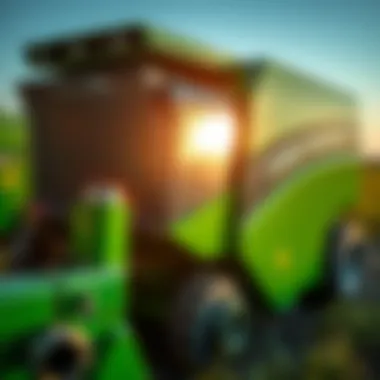
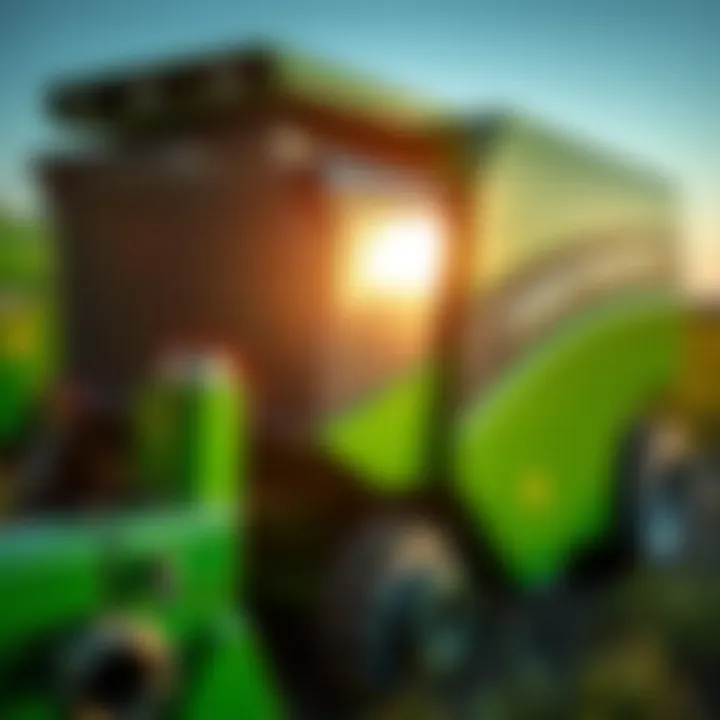
It's not just about the sticker price; consider the total cost of ownership to really understand the investment.
Long-term Investment in Machinery
Investing in a baler can seem daunting at first glance, but viewing it through the lens of long-term benefits often justifies the initial outlay. Here's why:
- Durability and Reliability: Quality balers are built to last. A good model may withstand years of heavy use and adapt to various farming conditions. Brands such as Case IH often highlight their machines' longevity and resilience.
- Resale Value: Equipment in good condition retains value. Should the need arise, selling a well-maintained baler could recoup a good chunk of the original investment.
- Technological Edge: Upgrading to a model with advanced features can open doors to efficiency. For instance, smart baling technology that links to mobile apps for diagnostics could save time and improve output.
- Financing Options: Many dealers and manufacturers offer financing plans that ease the burden of large purchases. These can be tailored to fit seasonal cash flow, making it manageable to invest in the equipment when necessary.
Ultimately, choosing a baler involves weighing both immediate costs and long-term benefits. A wise selection made today can yield dividends tomorrow, keeping farming operations efficient and sustainable.
Environmental Impacts of Baler Usage
In the realm of sustainable agriculture, understanding the environmental impacts of baler usage is crucial. As producers and land managers increasingly seek methods that lessen their environmental footprint, it's evident that machinery like balers plays a significant role. They not only improve efficiencies in crop management but also carry implications for energy use and overall ecological health. Analyzing these impacts helps farmers make informed decisions that could ultimately lead to better practices and cleaner agriculture.
Energy Consumption Patterns
When talking about energy sources, modern balers are often powered by either diesel engines or electric motors. Both types come with their own energy consumption rates, and this can greatly affect a farmer's operations. For instance, older baler models might run on engines that consume more fuel, leading to increased costs and carbon emissions. On the flip side, newer, more efficient models can significantly lessen this energy consumption, aligning with sustainability goals.
Farmers must also consider the energy consumed during production, transportation, and eventual disposal of the balers themselves. These processes require energy inputs and can contribute to cumulative environmental impacts.
Some facts to chew on regarding energy consumption in baler usage include:
- Fuel Type: Diesel balers are often efficient, yet their emissions are a constant concern.
- Efficiency Progress: As technology improves, many manufacturers are developing balers that are less demanding on energy sources.
- Electric Alternative: Electric balers, while less common, show promise for further reducing energy usage, especially in operations located close to power sources.
Carbon Footprint Analysis
Analyzing the carbon footprint of baler operations is essential for understanding their impact on climate change. Carbon emissions are a byproduct of fuel combustion in diesel engines and contribute to greenhouse gas accumulation. However, technology advancements are aiming to put a dent in this issue.
A few considerations when looking at the carbon footprint of balers include:
- Transportation Emissions: When the balers are transported to farms, emissions are produced based on the distance traveled.
- End-of-Life Impacts: The disposal or recycling of balers can also affect their overall carbon footprint. Selecting models that are more sustainable and recyclable can mitigate these impacts.
- Operational Choices: Decisions made by the farmer, from the type of fuel used to optimizing operational hours, influence the overall carbon footprint.
"Farming must evolve, aligning with responsibilities toward our planet and future generations. Incorporating efficient baler usage is part of this journey."
Understanding these elements not only allows farmers to optimize their machinery choices but also encourages a more sustainable approach to agriculture. As more growers recognize the long-term benefits of minimizing carbon footprints and energy waste, smarter or greener baler choices will become even more critical.
Future Trends in Baler Technology
Understanding the future trends in baler technology is crucial as it highlights how agriculture is evolving to meet the demands of increased efficiency and sustainability. As the farming landscape shifts towards smarter operations, new technologies are being integrated into balers, which not only boosts productivity but also addresses environmental concerns. The importance of this topic cannot be overstated—they reflect the direction that agricultural practices will take in the coming years.
Emerging Technologies in Agricultural Machinery
In the realm of agricultural machinery, balers are not lagging behind; they are evolving at a brisk pace. Current research and development focus on the following technologies and practices:
- Precision Agriculture: Adopting sensors and data analytics helps farmers to understand field variability, optimizing baler settings for moisture content in crops. This precision results in better quality bales and reduces waste significantly.
- Telematics: Many balers now come equipped with telematics systems that allow real-time monitoring and diagnostics. Farmers can access data from their smartphones or computers, leading to swift repairs and minimal downtime during critical baling seasons.
- Energy Efficiency: With a push towards sustainability, manufacturers are exploring electric and hybrid-powered balers. These alternatives could drastically reduce fuel costs and greenhouse gas emissions, aligning with global climate goals.
- Robotic Automation: The integration of robotics in baling operations simplifies the labor-intensive tasks like loading and unloading bales, thereby improving productivity and reducing labor costs. This trend is just starting to take root but promises a transformative future for agricultural processes.
These advancements are not mere enhancements; they represent a paradigm shift in how crops will be managed, harvested, and processed. Farmers relying on these technologies could experience significant returns on their investment, making their operations more resilient and competitive.
Lessons From Global Innovations
Looking globally, there are fascinating insights and lessons to be gleaned from innovations pushing the envelope in baler technology. Countries at the forefront of agricultural tech have demonstrated effective strategies that could be beneficial across diverse farming contexts:
- Research Collaborations: Countries like the Netherlands invest heavily in research partnerships between universities and agricultural equipment manufacturers. Such collaborations have led to revolutionary baler designs that optimize for different types of crops and conditions.
- Government Support for Innovation: In countries like Germany, government subsidies encourage farmers to switch to more technologically advanced equipment. These policies have enabled farmers to transition smoothly to mechanized baling systems, enhancing productivity without financial strain.
- Consumer Awareness and Market Demand: In regions like North America, there’s a growing consumer demand for sustainably produced goods. This trend has driven companies to innovate balers that not only improve efficiency but also ensure they contribute positively to environmental concerns.
Learning from these global trends allows farmers in other regions not just to keep pace but to adapt and innovate according to their local needs. Understanding such successes and adapting their principles can empower farmers to achieve similar results in productivity and sustainability.
The future of agriculture hinges on smart technologies and global cooperation, forming the backbone of sustainable practices.
Epilogue
Navigating the landscape of modern agriculture relies heavily on the intricate balance of machinery and natural processes, with green balers standing as a crucial component. The importance of understanding baler parts, their maintenance requirements, and emerging technologies cannot be overstated. This article has presented a comprehensive overview, highlighting how these elements coalesce to optimize farming operations while promoting sustainability.
Summary of Key Insights
A few significant insights emerge from our exploration:
- Critical Components: Key parts of balers, such as feed systems, compression chambers, and knotting mechanisms, have distinct roles that contribute to efficiency and quality in crop management.
- Maintenance is Essential: Regular checks and timely replacements of worn-out parts ensure the baler's longevity and prevent costly downtimes that can disrupt harvesting schedules.
- Technological Innovations: The advent of smart technologies and automation is transforming how balers function, offering farmers greater accuracy and improving their environmental footprint.
Another point worth noting is the impact on soil health through efficient baling, which speaks volumes about how equipment can play a role not just in production, but also in fostering ecological balance.
Recommendations for Practitioners
For farmers and agricultural workers keen on optimizing their baler operations, consider the following recommendations:
- Stay Educated: Keep abreast of the latest developments in baler technologies and sustainability practices. Engaging with resources such as Wikipedia and Britannica can sharpen your understanding.
- Invest in Quality Parts: When replacing components, choose quality parts. They may cost more upfront but can save significantly on repairs and replacements over time.
- Embrace Automation: Look into automated balers or those integrated with smart technology to not only increase efficiency but also reduce labor costs and minimize human error.
- Join Forums and Groups: Engage in platforms like Reddit or agricultural Facebook groups to share experiences and best practices with peers.
By implementing these strategies, practitioners can enhance their machinery's performance, thereby contributing positively to overall agricultural productivity. The journey through understanding green baler parts does not end here; it's an ongoing learning process that directly influences the future of farming.



